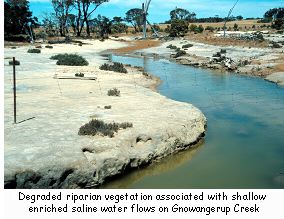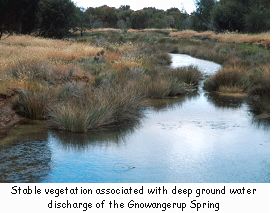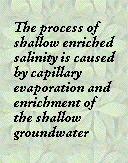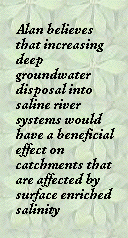
The Gnowangerup Spring is situated one kilometre north north-west of Gnowangerup and it discharges deep saline groundwater of 12,600 milligrams per litre at a constant rate of 4.1 litres per second into the Gnowangerup Creek.
The Gnowangerup Spring and Creek were used as an example in a recent study by Alan Seymour, who looked at how the disposal of deep saline groundwater was influencing the salinity of the creek and the health of the riparian vegetation. He has hypothesised that increasing deep groundwater disposal into rivers that are already affected by salinity will improve riparian stability and biodiversity.
The process of shallow enriched salinity is caused by capillary evaporation and enrichment of the shallow groundwater within about the top 1.5 metres of the soil profile. This process is especially evident in areas of slow groundwater discharge and high evaporation and is seen as a major factor that is contributing towards the degradation by salinity of the agricultural area in south Western Australia.
 The Outcomes and Observations
The Outcomes and Observations
This study found that the riparian vegetation associated with the Gnowangerup Spring appears to be healthier and more stable than that associated with shallow enriched saline water flows that are visible both up and downstream of the spring. Alan believes that the disposal of the deep groundwater from the spring has contributed towards low variations in creek salinity and a low variation in flow around the area of the spring. This has resulted in an unusual situation for a saline environment in that there is little variation in flow or salinity levels over the seasons. It appears that this increased environmental stability has resulted in a relatively high plant species diversity.
"It is hypothesised from knowledge of the Gnowangerup Spring that if stability of other saline environments were to be increased, by reducing the variations of river salinity and flow, the stability and health of the given saline environment would be expected to increase".
 Alan believes that increasing deep groundwater disposal into saline river systems would have a beneficial effect on catchments that are affected by surface enriched salinity by reducing:
Alan believes that increasing deep groundwater disposal into saline river systems would have a beneficial effect on catchments that are affected by surface enriched salinity by reducing:
- the area affected by shallow enriched salinity
- baseflow salinity
- variation of river flow salinity
- variation of river flow volume
- events of river flood
"Given that environmental stability is the key to protecting land against degradation, the constant abstraction and disposal of deep groundwater into rivers already affected by saline degradation holds promise to improve the ecological diversity and health of river systems".
Reference
Seymour, A. (1999). "Reducing the impacts of salinity by deep groundwater disposal in south Western Australia". Proceedings of the State Landcare Conference, Esperance, Western Australia, September 1999.





